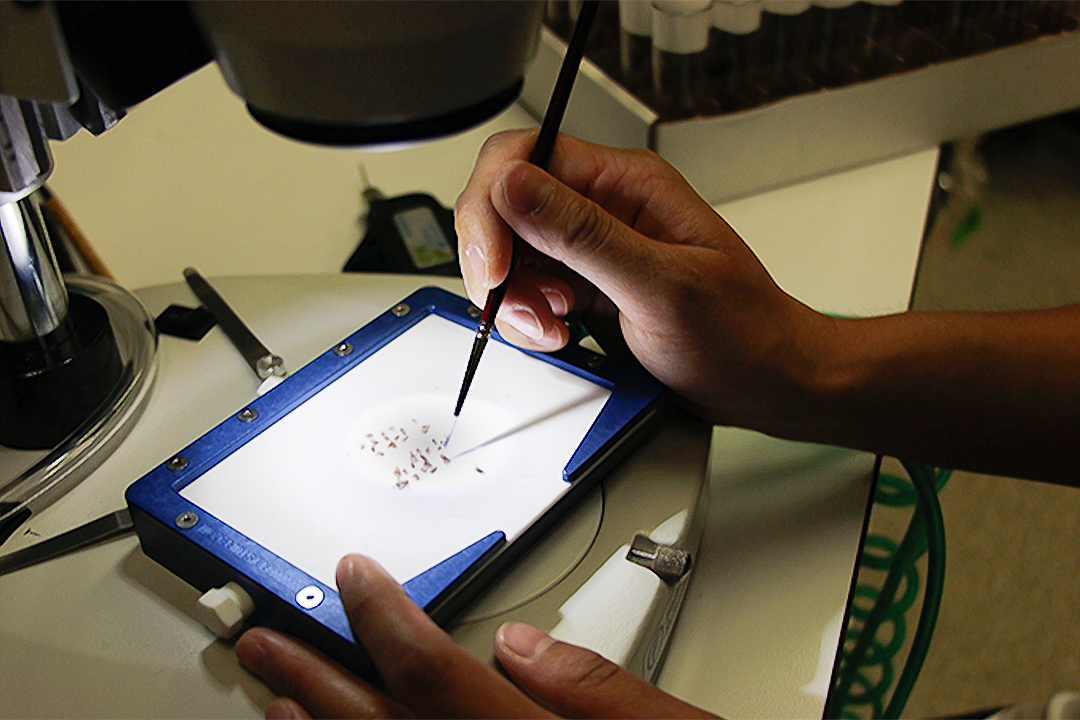
Fruit flies could help scientists achieve fruitful research
It’s hard to imagine a fruit fly being more than an unwanted nuisance around the ripe fruit in your kitchen, but researchers in Dr. Adelaine Leung’s lab at the Western College of Veterinary Medicine (WCVM) have found uses for the insect in more ways than you would think.
By Bonnie ChuFruit flies (Drosophila) are model organisms in biological research, in part due to their easy maintenance and their ability to reproduce quickly and effectively, much to the ire of their human hosts.
The simple organ systems of fruit flies make them ideal subjects for scientists to explore animals — their physiology and behaviours as well as their neural circuits, the pathways in the brain that operate the nervous system.
Compared to our nearly 100 billion neurons, fruit flies make do with only 100,000 — and that makes it much easier for scientists to trace the circuits in the fruit fly brain in order to visualize the connections that occur between sensory processing and the resulting behaviour.
Because Leung has ties to both physiology and biochemistry, she is uniquely poised within the WCVM to conduct research linking proteins to their respective roles in animal behaviour. Her keen interest in structural biology and her ability to manipulate protein structure to address deeper questions about function are factors that set Leung and her lab apart from other research groups at the University of Saskatchewan.
“I’m drawn towards behaviour … something complex, actions that require decision making,” says Leung, an assistant professor in the WCVM’s Department of Veterinary Biomedical Sciences. “These higher cognitive functions are so complicated, but fruit flies are really amenable to those studies, to answer those questions. It’s cheaper, it’s faster, and there’s less redundancy. That’s a key advantage.”
In particular, Leung and members of her research lab have been investigating nucleobindin-1 (NUCB1) and the role it plays in energy metabolism. NUCB1 is a protein released from the fruit fly brain that’s potentially a satiety molecule — it creates the feeling of fullness after eating.
A similar protein called nucleobindin-2 (NUCB2) exists in mammals, and when NUCB2 is injected into rats, it causes a decrease in their food intake and body weight.
Dr. Shreyas Jois, a postdoctoral fellow in Leung's research lab, has been investigating NUCB1. His preliminary results suggest that silencing NUCB1 expression in the fruit fly neurons causes the flies to exhibit dramatic physiological defects that range from small body size to stunted wings to impaired mobility and fertility.
“I was surprised by how severe this effect was,” says Jois. “The entire genome of Drosophila is sequenced and about 75 per cent of human disease genes are believed to have a functional counterpart in flies, so these results, and much of what we study in flies, is highly relevant to us.”
To learn more about NUCB1 and its potential significance, the researchers set out to determine when and where the protein is expressed.
Using fluorescently tagged antibodies, the scientists were able to look at the pattern of NUCB1 distribution in the central nervous system. They found that this molecule was most consistently concentrated in an area of the fruit fly’s brain called the larval ring gland.
Since the ring gland is like the pituitary gland in mammals and is responsible for endocrine functions such as reproduction, growth, development and energy production, the researchers believe there’s a good chance that it also controls the secretion of NUCB1.
They have also determined that the NUCB1 molecule may be localized in the adult pars intercerebralis, the region of the fruit fly brain that plays a similar role to that of the mammalian hypothalamus. In mammals, the hypothalamus contains the control system for the nervous system, and it affects the endocrine system by interacting with the pituitary gland.
Having seen that NUCB1 is expressed in nervous tissues and particularly in endocrine or hormone-releasing centres, the researchers set out to determine if and how manipulating diet would affect the NUCB1 expression levels.
They began by depriving the adult flies and larvae of food for set time points. The researchers then measured the NUCB1 levels in their brains to determine if there were differences in the NUCB1 levels of the hungry flies compared to the flies that had been fed.
“Researchers working with vertebrate models have reported that NUCB1 expression is influenced by diet,” says Jois. “With a technique called qPCR, we can quantitatively study gene expression.”
In future studies the researchers plan to investigate whether changing the diet composition — the proportions of fat, carbohydrates, and protein, for example — influences the levels of NUCB1 expressed in the brain.
“In mammals and fish, NUCB peptide has an anorexigenic [appetite-suppressing] effect on food intake, and this has important biomedical applications — researchers in this field have been considering using NUCB as an oral ingestion or a nasal spray,” says Jois. “Using NUCB1, we can start to understand the mechanism of how the dysregulation of food intake impacts obesity.”
By taking advantage of the extensive genetic toolbox of the fruit fly to overexpress and to silence the NUCB1 gene in various subsets of cells, Leung’s research team has been able to observe the physiology and behaviours that result from these manipulations.
“We need to take advantage of Drosophila genetics to answer questions that can’t be answered in the mammalian system. We all have an innate desire to find things out, so doing research, being inquisitive, is something that matters to everyone,” says Leung.
If NUCB1 is a potent regulator of energy intake and metabolism, the researchers are optimistic that by further characterizing its role in the humble fruit fly, they may discover the key to treating human obesity as well as other metabolic diseases.
Bonnie Chu of Vancouver, B.C., is a fourth-year veterinary student who was part of the WCVM’s Undergraduate Summer Research and Leadership program in 2017. Bonnie’s story is part of a series of stories written by WCVM summer research students.
